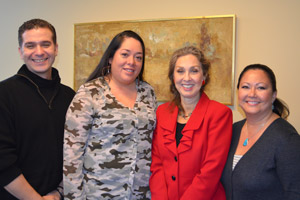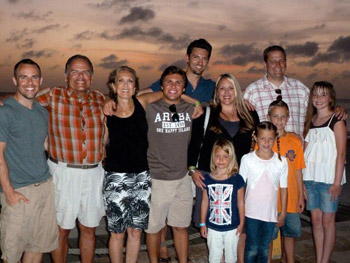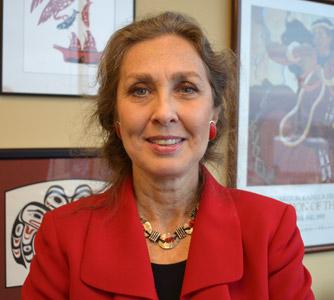Dedra Buchwald came to the UW as a pioneer in chronic fatigue research. Her passion for cross-cultural work soon led her to explore Native American health issues. Today she is director of the Center for Clinical and Epidemiological Research, the umbrella organization of Partnerships for Native Health, which recently became part of the School of Public Health.
How did you get interested in Native health issues?
Before I came to the UW, I was a fellow at Harvard and I was moonlighting at a clinic in a Boston suburb. It was in a cinderblock bunker in the middle of a Portuguese ghetto. I really liked the cross-cultural aspects, so I applied for a job in Seattle as director of the Refugee Health Program at Harborview Medical Center. I met my husband, Spero Manson, at a conference shortly thereafter. He's a cultural anthropologist at the University of Colorado and his heritage is the Pembina Chippewa Tribe. He was completely enmeshed in American Indian mental health and substance abuse research. Because of the cross-cultural medical care I had done, the transition came fairly easily.

Buchwald (second from right) with Native researchers Lonnie Nelson, Abigail Echo-Hawk and Ka'imi Sinclair.
Tell us about the Partnerships for Native Health.
We have a large multidisciplinary group here working on 22 active Native projects, including health literacy, diabetes education, stroke, mobile health, behavior change, and more. Our partners include clinical experts, social scientists and even lawyers. One of our goals is to bring in people who want to work with Native communities and who have new areas of expertise. Our tribal liaison Abigail Echo-Hawk teaches a three-hour seminar on working with Native communities. She will conduct these sessions for groups of interested people within the University.
And you're doing a lot of training?
The Native Investigator Development Program brings in Native scientists from around the country for two years of intensive mentoring spread over four to five in-person meetings and weekly phone calls. The Native investigators produce a secondary data analysis, conduct a primary data collection pilot project, and then write a grant. I love mentoring junior faculty and students and discovering the strength of all the people I work with. We've trained 42 Native scientists. They've written close to 300 papers and have received close to $60 million in grants as principal and co-investigators since their training. Most of them had no funding before they came.
Working With Native researchers, faculty, and students
What is the focus of the training?
Research design, biostatistics, social networks with other scientists, and personal successes and challenges. One of our mantras is that we need to do the highest level of science in American Indian and Alaska Native communities that is meaningful and addresses priorities. Native investigators have a special obligation to carry on this tradition. Over the years, researchers have often conducted research without participation from local people and done work that's not meaningful to the community. The rigor of the science is really important because our partner Native communities rely on resulting information to address inequities.
We also help our Native investigators with other non-scientific issues that come up. They're just as important for success. How do you manage your time if you're the only Native faculty member in the school? You're asked to do everything. You are diversity personified. How do you handle that role, how do you say no, and how do you watch out for yourself and your career?
What kind of impact have your projects had?
We just finished a big study on cerebral vascular disease in 12 American Indian communities. All of the major studies in the US on stroke and cerebrovascular disease have left out Native people. Our team and colleagues at the Strong Heart Study have highlighted that the first-time stroke rate for Native people is higher than for any other racial or ethnic group in the US. We did MRIs in these 12 Native communities to examine subclinical cerebrovascular disease and cognitive impairment. This study is receiving a lot of publicity, resulting in more research that will benefit these communities. It's been a huge undertaking.
We also did a series of health literacy studies on how to communicate with people in Native communities. We found there was an astronomical increase in comprehension when pictures were used to communicate numerical and health concepts. The whole tradition of art and visual thinking is very important.
HIGHLIGHTS
- Professor, Epidemiology and Medicine
- Director, Center for Clinical and Epidemiological Research
- Director, Partnerships for Native Health
- Attending physician, International Medicine Clinic, HMC
- Medical Director, Chronic Fatigue Clinic, HMC
- MD, UC-San Diego
- BA, Neurology, UC-San Diego
Tell us the story about the UW Twin Registry.
I lost my Washington State driver's license about 15 years ago and had to get a new one. Being a good German, I grabbed all the forms in the Department of Licensing office in downtown Seattle. This was in the day of paper forms. There was a question on the form: "Are you a twin or a triplet?" My first thought was….What a weird question to ask someone for a driver's license!
It turns out that the state uses the first five letters of your last name, the initials of your first and middle names, and an encrypted number based on your date of birth. So obviously, license numbers could be the same for twins or even for people born on the same day with common names. Years ago, police would occasionally end up arresting the wrong people – the wrong twin. So the Department of Licensing added the question on twins. If you answer yes, a random license number is generated. When I figured all this out, I said, "Wow, we could have a twin registry here in this state." We then negotiated with the Washington Attorney General so we could partner with the Department of Licensing and collect the data needed.
How many twins are enrolled?
Almost 10,000 pairs. Every twin's residence is GIS coded, which gives us walkability scores for their neighborhoods. We also have collected information on health conditions, light pollution, noise pollution, and socioeconomic index. Our registry is also linked to the state's hospital admission database. Glen Duncan (Associate Professor of Epidemiology in the Nutritional Sciences Program) has taken over managing the registry in the last year and is expanding it to children.
What can we learn about our health and well-being from studying twins?
STUDYING TWINS ALLOWS SCIENTISTS TO ASK THE NATURE VERSUS NURTURE QUESTION
Jack Goldberg (Research Professor of Epidemiology) always used to say that you can ask any question you like in a study, but if you do the study with twins, then you can ask the "nature versus nurture" question. In a twin study, you can parse out three influences. One is genetic/familial influences. The second is the contribution of the unique environment (say, the twins go to different universities), and the third is common environment (such as your mother's home cooking). All those things influence a trait or condition.

Dedra Buchwald next to her husband Spero Manson (in plaid shirt), with kids and grandkids
You're also known for your chronic fatigue research.
I was working at Harvard when chronic fatigue first came to the forefront. By the time I was done with my fellowship, I had eight publications, because I was in the right place at the right time and had a great mentor. I continued that clinical work when I came out here, and it's always been commingled with my research. My colleagues now conduct amazing research on chronic pelvic pain, jaw pain, chronic headaches, fatigue, and the many psychosocial and environmental influences on these puzzling conditions.
What do you like to do when you're not working?
My main hobbies are cycling, working out (weightlifting, aerobic type stuff), travel, and artsy things (I make cards).
(By Jeff Hodson)
Originally published: February 2014
